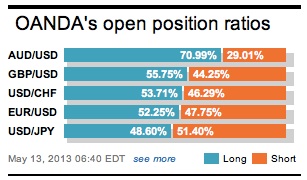Now what? The FX market has got what it been coveting for many months, albeit a few weeks earlier than originally planned – USD/Yen trading north of the psychological 100 print. The pair, currently meandering through ‘no-mans territory’ is more influenced by the markets perception of the Fed’s attitude towards QE and a potential exit strategy rather than Abenomics reasoning. Is the market to grind out further dollar supporting gains or are investors to reload on pullbacks and keep the faith in the BoJ?

At the G7 ‘boys’ club this past weekend, Japan continues to get the green light and thumbs-up from fellow members for the Yen’s depreciation. Japan’s Finance Minister Aso said there had been “no criticism of Japan’s policy from the G7,” while the Bank of Japan governor added that the G7’s understanding of his strategy has deepened. The original members should not worry global markets. It’s the remaining members that make up the G20, the emerging economies particularly in Asia that investors need to keep an eye on. These members fear that they may be squeezed into a competitive disadvantage by Japans actions and will soon be voicing their own concerns about the Yen’s value. This will become more of a global concern when the emerging central banks have exhausted domestic monetary routes to manipulate their own currency values – like the Bank of Korea.
The Euro-zone members currently have a different agenda and Japan is ‘not’ at the top of their list. On Saturday, Euro-policy makers expressed a willingness to consider new ways to revive their ailing economy as they confront fresh stateside pressure to take action. A “tale of two countries” – the German and French economic conditions highlight the regions uphill problem. Earlier this morning, the German economic minister reported that domestic growth is expected to pick up speed as the year goes on. On the other hand, the French central bank believes their own economy will expand at the same pace all year and will probably “eke out meager growth in Q2.” The problem, Europe’s “all for one and one for all” methodology supposedly will not work. Germany’s Merkel staunchly defends economic austerity and fiscal restructuring – their own economy is performing – while Frances President Holland wants to loosen the financial shackles and do more to stimulate his economy – the American way. Outside pressure wants Merkel to consider alternatives just as the ECB are – when you are in control it’s easier to be optimistic, but the Euro reality paints a different picture!

This week’s US data will be an important testing ground for the current dollar rally. The mighty greenback is being pushed higher, aided by the markets speculative belief that the Fed has come up with a strategy to wind down its $85-billion per month bond buying program. Although it has not been decided when to start, investors are speculating that US officials are planning to reduce the amount of bonds they are willing to buy. With the USD currently dominating proceedings any greenback weakness should be selective.
Weaker data would cause the USD to lose some ground, most likely against a more select basket of currencies compared to the broad nature of May’s dollar rally. Abenomics will support a weaker Yen – investors who sold the dollar too early ahead of ¥100 will be back and are likely to chase the pair higher again. However, option barriers just south of 105 should cap USD/JPY in the medium term. The EUR and GBP, both currencies somewhat technically in oversold territory, may have the opportunity to recoup some of their losses especially in the event of firm data in Europe. The market expects Euro area GDP to have increased by +0.1%, q/q in Q1 this week. This would mean that the area has left a technical recession. In the UK, investors are bracing themselves for a relatively solid labor market data later in the week.

In the US, the markets main focus this week will be the April retail sales report this morning. Some analysts are expecting lower prices to generate the first back-to-back decline in US retail sales in 12-months. A big price-related drop in gas prices should be the main drag on headline retail sales. Also this week we get US manufacturing – which has been “sputtering” of late. The May updates will come from the Empire State and Philly Fed, while April reports the national industrial production. Investors will want to keep an eye on the housing data – it has been a “moderate bright spot.” Analysts again expect a firm reading, however, the winter weather will create the usual volatility. This week the mighty dollar should see more volatility mostly on the back of more fundamental data.

Other Links:
A Yen For Help – Do Not Bother
This article is for general information purposes only. It is not investment advice or a solution to buy or sell securities. Opinions are the authors; not necessarily that of OANDA Corporation or any of its affiliates, subsidiaries, officers or directors. Leveraged trading is high risk and not suitable for all. You could lose all of your deposited funds.


